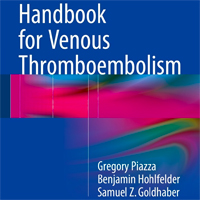Tag: anticoagulants
Fever Management with or without a Temperature Control Device After OHCA and Resuscitation
the TEMP‐CARE trial will advance our understanding of post‐cardiac arrest care fever management strategies. With a large sample size and a broad patient population, the results of this trial will inform clinical practice... read more
Different Anticoagulation Regimens Effectiveness in Critically Ill Patients
This study compared the efficacy of therapeutic anticoagulation guided by anti-Xa levels vs. a D-dimer-based protocol in ICU patients with COVID-19. Given the heightened risk of thrombosis despite anticoagulation therapy... read more
Handbook for Venous Thromboembolism
A truly practical guidebook for anyone who needs the key information on the diagnosis, management and prevention of venous thromboembolism. Specific areas of focus include understanding the risk factors for VTE and the role... read more

Heparin-based vs. Bivalirudin-based Anticoagulation in Pediatric ECMO
Bivalirudin may be a safe, cost-effective alternative to heparin in achieving anticoagulation in pediatric extracorporeal membrane oxygenation (ECMO) patients. Prospective multicenter studies and randomized control trials... read more
Anticoagulation in COVID-19 Patients
Clinical, laboratory, and autopsy findings support an association between COVID-19 and thromboembolic disease. Acute COVID-19 infection is characterized by mononuclear cell reactivity and pan-endothelialitis, contributing... read more
Ascending Aortic Thrombus After COVID-19 Infection
SARS-CoV-2 predisposes patients to both venous and arterial thromboembolism, including ascending aortic thrombus. The current guidelines for anticoagulation recommend three to six months of continuous anticoagulation... read more
Subsegmental Pulmonary Embolism Increased Rate of Recurrent VTE
Overall, patients with subsegmental pulmonary embolism who did not have proximal deep venous thrombosis had a higher-than-expected rate of recurrent venous thromboembolism (VTE). Recruitment was stopped prematurely because... read more
Early Hemostatic Management of Disseminated Intravascular Coagulopathy
Inflammation and coagulation pathobiology play a significant role in the development of multiorgan failure occurring with sepsis. Inflammation induced by an infection can lead to endothelial injury, which subsequently... read more
Rapid detection of clinically-relevant plasma direct oral anticoagulant levels following acute traumatic injury
In urgent clinical situations, such as trauma, urgent surgery or before thrombolysis, rapid quantification of direct oral anticoagulant plasma drug levels is warranted. Using the ClotPro® analyser, we assessed two novel... read more
The Evolving Armamentarium of COVID-19 Therapeutics
Multiple repositories have been created for the vast scientific outpouring of COVID-19 research. The NIH regularly updates its treatment guidelines, which will be the primary reference for this review. To cut to the... read more
Blood Thinners May Improve Survival Among Hospitalized COVID-19 Patients
Treating hospitalized COVID-19 patients with anticoagulants--blood thinners that slow down clotting--may improve their chances of survival, researchers from the Mount Sinai COVID Informatics Center report. The study,... read more
Sudden Abdominal Pain with a Palpable Mass
Rectus sheath hematoma (RSH) is a rare cause of abdominal pain that is often overlooked when patients present for evaluation. The disease can mimic almost any other type of abdominal pathology, and thus the diagnosis is frequently... read more
Blood Grouping Identifies Patients at Risk for Developing Venous Thromboembolism
Based on study of more than 28,000 TJA patients, presurgical ABO blood group testing looks like an inexpensive way to identify patents at increased risk for symptomatic postoperative VTE. Prophylaxis regimens can dramatically... read more
Pulmonary Embolism Hospitalization, Readmission, and Mortality Rates in US Older Adults
Over the past 15 years, advances have occurred in the diagnosis and management of pulmonary embolism (PE).1 Computed tomographic pulmonary angiography (CTPA) is now the routine diagnostic test. The availability of risk... read more
Anticoagulant Reversal
Ranjit Deshpande, MD, and Mark D. Cipolle, MD, PhD, FCCM, discuss Dr. Cipolle's talk from the 48th Critical Care Congress on what's new in anticoagulant reversal. Tune in to hear about the hottest topics and current research.... read more
Thromboelastography Predicts Thromboembolism in Critically Ill Coagulopathic Patients
Critically ill patients with deranged conventional coagulation tests are often perceived to have an increased bleeding risk. Whether anticoagulant prophylaxis for these patients should be withheld is contentious. This study... read more
Cast of the Right Bronchial Tree
A 36-year-old man was admitted to the intensive care unit with an acute exacerbation of chronic heart failure. His medical history included heart failure with an ejection fraction of 20%, bioprosthetic aortic-valve replacement... read more
Novel Oral Anticoagulants and Trauma
The number of anticoagulated trauma patients is increasing. Trauma patients on warfarin have been found to have poor outcomes, particularly after intracranial hemorrhage (ICH). However, the effect of novel oral anticoagulants... read more
Discharge Instructions for VTE: A Comprehensive Approach to Medication Management
Discharge instructions for VTE have typically included medication management recommendations related to the use of warfarin. In recent years, however, a growing number of alternatives to warfarin, such as direct oral anticoagulants... read more
Pharmacomechanical Catheter-Directed Thrombolysis for Deep-Vein Thrombosis
The post-thrombotic syndrome frequently develops in patients with proximal deep-vein thrombosis despite treatment with anticoagulant therapy. Pharmacomechanical catheter-directed thrombolysis (hereafter "pharmacomechanical... read more
Direct Oral Anticoagulant- or Warfarin-Related Major Bleeding
Direct oral anticoagulants (DOACs) have expanded the armamentarium for antithrombotic therapy. Although DOAC-related major bleeding was associated with favorable outcomes compared with warfarin in clinical trials, warfarin... read more
Dose-Adjusted DOACs: What Efficacy vs Warfarin?
The direct oral anticoagulants (DOACs) offer distinct advantages over warfarin - among them, dose adjustment is only needed in cases of impaired renal function, advanced age, low body weight, or potential for drug-drug interactions.... read more









